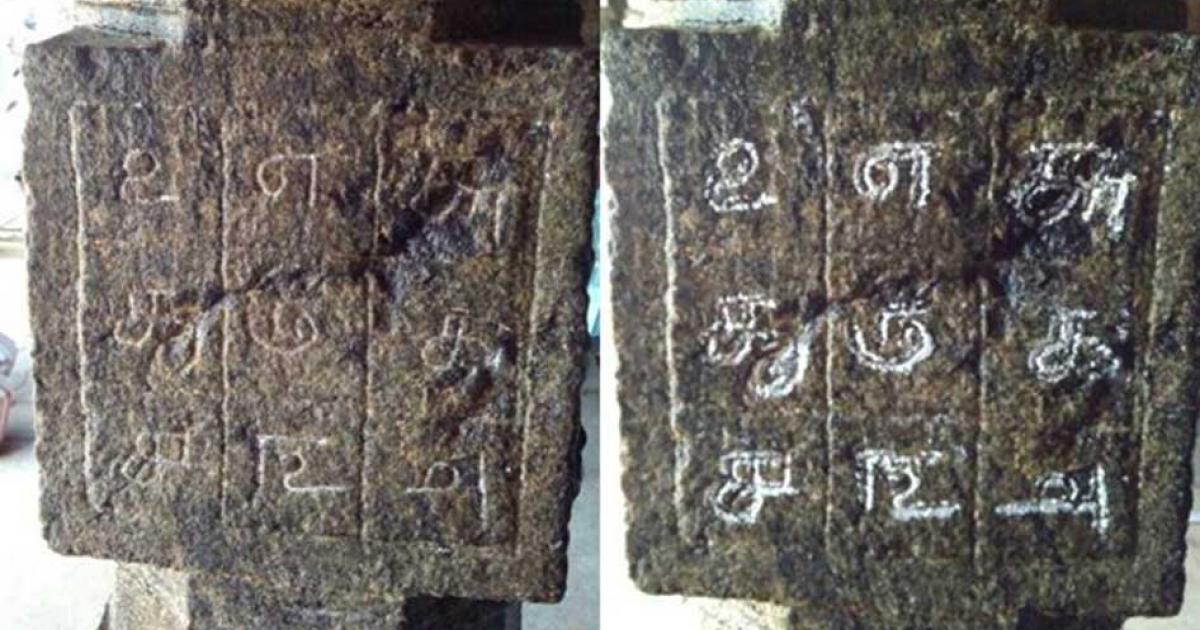
South Indian Sudoku: Archaeologists Find Magic Square Puzzle Inscribed on Temple Pillar
Archaeologists in India have discovered a rare 300-year-old inscription of a sudoku-like game on the pillar of a temple in Palani, India. When added in any direction, the numbers total 15, which is the number associated with the temple’s deity.
The News Minute reports that researchers made the discovery while making repairs to a pillar in a 13 th century mandapam, a pillared outdoor pavilion used for public rituals, located in the foothills of Palani, a pilgrim town in Tamil Nadu, India.
The inscription had been hidden under multiple coatings of limestone, but was revealed during the repairs on the temple. This particular mandapam is used during the Panguni Uthiram festival, which is celebrated by Hindus on the full moon day of the Tamil month of Panguni in March/April.

Example of a mandapam pavilion, similar to the one upon which the magic square puzzle was found (CC by SA 3.0)
3 x 3 Magic Square
According to News Minute, archaeologist Narayanamoorthy said the inscription is an example of a 3x3 magic square, which most likely belongs to the 17 th century. The numbers are written in Tamil, and when added together horizontally, vertically, and diagonally, total to 15. Narayanamoorthy points out that the number 15 is association with the temple deity’s Murugan / Lord Muruga, a Hindu god of war.
“According to Hindu beliefs, every god has a number and Lord Muruga’s number is 6 (1+5=6),” said Narayanamoorthy [via News Minute]. “Interestingly, during festivities, the deity is placed in front of this pillar. Inscriptions of these Sudoku squares here could indicate its importance. What we gather from this is that the game's logic was used here long before it was played elsewhere in the world.”

8th century sculpture of Muruga, the temple’s deity (CC by SA 3.0)
Origins of the Magic Square
A magic square is a popular number puzzle in which the sum of every row, column and diagonal in a n x n square grid is equal.
Sudoku is a particular type of magic square involving a 9 x 9 grid with nine 3 x 3 sub-grids, which first appeared in newspapers in the late 19 th century. But magic squares in general have a much longer history, dating back to at least the 7 th century BC in China. In ancient times, the puzzle was attached with magical or mythical significance. Some forms of the puzzle were used in conjunction with letters to assist Arab illusionists and magicians.
- New Piece of a 2,200-Year-Old Roman Puzzle Emerges, Bringing Together Ancient Map of Rome
- Fun for Everyone: The Evolving History of Board Games

Iron plate with Arabic numbers arranged in a 6 × 6 grid to form a magic square adding up to 111 horizontally, vertically and diagonally. Yuan Dynasty (1206-1368). Currently housed at the Shaanxi History Museum in Xi'an.(CC by SA 3.0)
The first recorded reference to a magic square is dated to 650 BC and is associated with an ancient Chinese legend. Tathaastu recounts the story:
“The legend goes that one of the great emperors of China once found a tortoise shell during a flood of the river Lo. This was a highly auspicious omen as the people in those times believed that God lived inside tortoise and turtle shells. This particular tortoise shell had extraordinary markings – it contained a perfect, three-by-three square on its back. This square is known as the Lo Shu grid. This square was remarkable because every horizontal, vertical, and diagonal row added up to fifteen. Fifteen is the number of days between the new moon and the full moon. The number five was highly regarded in ancient China and this magic square contained a five in the central position.”
Magic Squares in India
The earliest known use of the magic square in India dates back to the 1 st century AD, and is found in a text called Kaksaputa, written by the alchemist Nagarjuna. Like the example found above the entrance of a temple in Khajuraho, India, all the squares mentioned by Nagarjuna are 4 x 4 magic squares.

Four by four magic square at the entrance of 10 th century Parsvanatha temple, Khajuraho, India. (CC by SA 3.0)
The 3 x 3 square, like the one recently revealed on the pillar in Palani, has been used in India as part of ritual and ceremony since Vedic times, and is still used today. A 10 th century medical text called Siddhayog, prescribed a 3 x 3 magic square, known as Vrnda’s square, to assist women in labour. They were also used in honor of deities, who were associated with a particular number.
Top image: Newly-discovered magic square in Palani, India. Credit: News Minute















